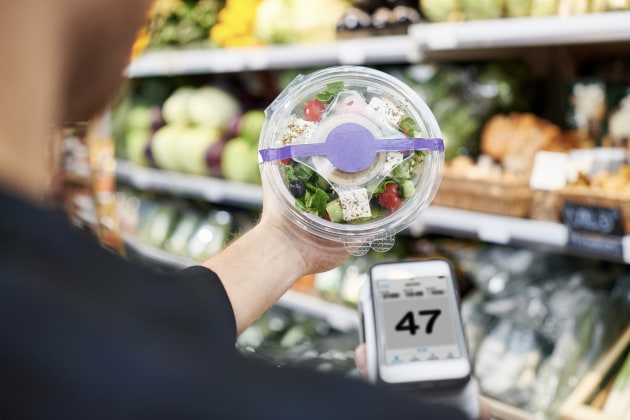From boosting supply chain transparency to enabling circularity and reducing waste, RFID technology is reshaping sustainable packaging systems. Avery Dennison explores how digital tools like atma.io and recyclable RFID labels are helping brands meet their environmental goals.

As demand for transparency across the packaging value chain grows, solutions like atma.io are helping brands deliver on consumer expectations and regulatory requirements. The platform assigns a unique digital identity to each product, creating what is known as a digital twin. Much like a fingerprint, this twin enables comprehensive tracking of a product’s lifecycle – from sourcing and manufacturing to distribution, retail, use, and eventual recycling.
Data-backed decisions
This end-to-end traceability empowers businesses to make more informed decisions. By monitoring every step in the product journey, brands can identify operational inefficiencies, uncover areas of excess waste, and take targeted action to drive improvements. It also enables them to substantiate sustainability claims with data and enhance their ability to meet circularity goals.
For consumers, the benefit lies in greater access to information. By scanning a product, shoppers can learn about its origins, ethical sourcing credentials, certifications such as carbon neutrality or organic status, and even how to responsibly dispose of or recycle it. One example of this in action is the use of atma.io to track fresh food products, such as locally sourced salmon, providing assurance that supply chains are both responsible and transparent.
Smarter inventory management
In sectors such as food and beverage, poorly managed inventory often results in expired goods, overstocking, or missed sales opportunities. RFID-enabled systems are helping businesses tackle this issue head-on. Unlike barcodes, which require line-of-sight scanning, RFID tags can be read automatically and in bulk, giving businesses real-time visibility into stock levels and movement.
This level of oversight allows companies to fine-tune their supply chains. Products nearing expiry can be prioritised, replenishment can be more accurately timed, and stock can be redirected where demand is highest. With better control comes less waste, lower operational costs, and a smoother customer experience.
Automation also plays a key role. RFID reduces the need for manual stocktaking, improving accuracy and freeing up staff resources. Companies such as Kroger, Walmart and Chipotle have embraced the technology to strengthen their supply chains and reduce shrinkage, while aligning inventory processes with sustainability ambitions.
Breaking new ground
A critical hurdle in integrating RFID with packaging sustainability has been the recyclability of RFID labels themselves. Traditionally, these labels could contaminate recycling streams, particularly in PET packaging. However, a recent breakthrough by Avery Dennison is changing that narrative.
The company has developed the first RFID label to receive Association of Plastic Recyclers (APR) Design recognition for recyclability. This label, which features CleanFlake adhesive, is designed to separate cleanly from PET substrates during mechanical recycling. As a result, it avoids leaving behind residue or interfering with the reprocessing of plastic material.
This is particularly important given the widespread use of PET in food, beverage and personal care packaging. By eliminating a common source of recycling contamination, the innovation improves the yield and quality of recycled PET, reducing dependency on virgin plastic and helping brands close the loop on packaging.
As Steve Alexander, CEO of APR, puts it, “By increasing recyclability, brands not only reduce waste but actively contribute to a more sustainable future.”
Broader sustainability role
While RFID’s role in improving packaging efficiency is clear, its broader impact on sustainability strategies is just as compelling. The technology allows brands to quantify key environmental metrics, such as the carbon footprint of individual products, across the full value chain. These insights can inform ESG reporting, guide emissions reduction strategies, and support compliance with emerging regulations.
RFID also enhances consumer engagement. Each tagged product becomes a direct digital touchpoint, enabling customers to interact with brands, access verified product stories, and better understand their purchasing impact. This fosters transparency and trust, while empowering consumers to make more informed choices.
Importantly, RFID can also support circularity by tracking products after they leave the shelf. Brands can monitor return or reuse programs, incentivise recycling, and gain visibility into post-consumer product flows, further embedding sustainability into the full lifecycle.
Leading sustainability via digital transformation
As the packaging sector continues to evolve under the weight of environmental pressures, RFID technology is emerging as a powerful tool to support progress. It combines data-driven efficiency with practical sustainability outcomes, helping brands reduce waste, streamline operations, and connect with conscious consumers.
Whether through end-to-end traceability with platforms like atma.io, smarter inventory management, or the rollout of recyclable RFID labels, the potential applications are wide-ranging. For packaging professionals looking to future-proof their operations while advancing circularity goals, RFID offers a tangible path forward.
This article was first published in the July-August 2025 print issue of PKN Packaging News, p14.






